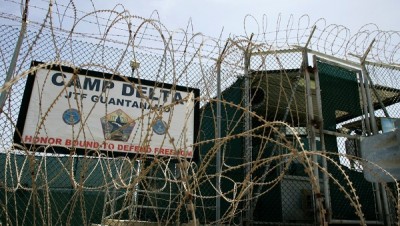Close Guantanamo and Return It to Cuba

President Obama has the constitutional power to shut down the prison there and return Guantanamo to Cuba.
Obama has yet to fulfill the promise he made in his January 22, 2009 executive order to shutter Guantanamo “no later than one year from the date of this order.” Any individuals remaining there at the time of closure, Obama wrote, “shall be returned to their home country, released, transferred to a third country, or transferred to another United States detention facility in a manner consistent with law and the national security and foreign policy interests of the United States.”
After threatening to veto the final draft of the annual National Defense Authorization Act (NDAA) partly because it forbids the transfer of Guantanamo detainees to the United States and tightens barriers to sending them to other countries, Obama caved. A White House spokesperson said Obama would sign the legislation, which passed overwhelmingly in the House and Senate. Bernie Sanders was one of three senators to vote against the bill.
 Nearly seven years after Obama’s promise, 112 men remain at Guantanamo, half of whom have been cleared for release. Obama has released 54 prisoners and is reviewing the cases of others still being held.
Nearly seven years after Obama’s promise, 112 men remain at Guantanamo, half of whom have been cleared for release. Obama has released 54 prisoners and is reviewing the cases of others still being held.
In March 2011, Obama designated 46 men to remain in indefinite detention without trial, but promised periodic review of their cases. Arbitrary detention violates the International Covenant on Civil and Political Rights, a treaty the United States has ratified, making it part of U.S. law under the Supremacy Clause of the U.S. constitution.
The periodic reviews didn’t start until November 2013, spurred by hunger strikes at the prison. The reviews continue to be conducted. As a result of those reviews, 14 additional men were cleared for release and five of them have been released.
In April 2013, Obama said, “I think it is critical for us to understand that Guantanamo is not necessary to keep America safe . . . It hurts us in terms of our international standing . . . It is a recruitment tool for extremists. It needs to be closed.” Yet it remains open.
One of the transfer restrictions required the secretary of defense to notify Congress 30 days before transfer that it would be good for national security. But to avoid being personally responsible if a detainee were to become a terrorist, former Defense Secretary Chuck Hagel hesitated to allow transfers. Actually only seven percent of the detainees released during Obama’s tenure returned to terrorist activity as compared with 19 percent during Bush’s presidency.
Obama is reportedly preparing a plan to speed up transfers of half the remaining Guantanamo prisoners to their home countries or other willing nations. The plan will also set forth new security protocols to prevent detainees from returning to terrorist activities once released.
Military experts are conducting surveys of prisons in the United States for possible transfer of detainees. They include the military prison at Ft. Leavenworth, Kansas; the Naval Consolidated Brig in Charleston, South Carolina; and the US supermax prison in Florence, Colorado.
In spite of the NDAA, Obama has the power to close Guantanamo. Former White House counsel Gregory Craig and Cliff Sloan, former special envoy for Guantanamo closure, maintain, “the president does not need Congress’s authorization to act.” They wrote in the Washington Post, “Under Article II of the Constitution, the president has exclusive authority to determine the facilities in which military detainees are held . . . The determination on where to hold detainees is a tactical judgment at the very core of the president’s role as commander in chief.”
According to Craig and Sloan, “Congress’s purported ban on funding any movement of detainees from Guantanamo Bay to the United States restricts where ‘law-of-war’ detainees can be held and prevents the president from discharging his constitutionally assigned function of making tactical military decisions. Accordingly, it violates the separation of powers.”
Lt. Col. David Frakt, who has represented Guantanamo detainees before the military commissions and in federal habeas corpus proceedings, concurs. “When the Obama administration really wants to transfer a detainee, they are quite capable of doing so,” Frakt wrote in JURIST. He said Obama should direct his attorney general to inform the D.C. Circuit Court of Appeals that the Department of Justice no longer considers the cleared detainees to be detainable.
Col. Morris Davis, former Chief Prosecutor for the Terrorism Trials at Guantanamo, personally charged Osama bin Laden’s driver Salim Hamdan, Australian David Hicks, and Canadian teen Omar Khadr. All three were convicted and have been released from Guantanamo. “There is something fundamentally wrong with a system where not being charged with a war crime keeps you locked away indefinitely and a war crime conviction is your ticket home,” Davis wrote to Obama.
Of the 780 men held at Guantanamo since 2002, only eight were tried and convicted of war crimes. Of those, just three remain at Guantanamo.
Many of the detainees reported being assaulted, prolonged shackling, sexual abuse, and threats with dogs. Australian lawyer Richard Bourke, who has represented several Guantanamo detainees, charged they have been subjected to “good old-fashioned torture.” Detainees who engage in hunger strikes are subjected to force-feeding, a practice the UN Human Rights Council has called torture or cruel, inhuman or degrading treatment. At least seven men have died at the prison camp.
The United States has illegally occupied Guantánamo since 1903, after Cuba’s war of independence against Spain. Cuba was forced to include the Platt Amendment in the Cuban constitution. The amendment granted the United States the right to intervene in Cuba as a prerequisite for the withdrawal of US troops from the rest of Cuba. That provision provided the basis for the 1903 Agreement on Coaling and Naval Stations, which gave the United States the right to use Guantánamo Bay “exclusively as coaling or naval stations, and for no other purpose.”
President Franklin D. Roosevelt signed a new treaty with Cuba in 1934 that allows the United States to remain in Guantánamo Bay until the US abandons it or until both Cuba and the United States agree to modify their arrangement. According to that treaty, “the stipulations of [the 1903] agreement with regard to the naval station of Guantánamo shall continue in effect.” That means Guantánamo Bay can be used for nothing but coaling or naval stations. Article III of the 1934 treaty also says that Cuba leases Guantánamo Bay to the United States “for coaling and naval stations.” Nowhere in either treaty did Cuba give the US the right to utilize Guantánamo Bay as a prison camp.
Former Cuban president Fidel Castro has long maintained that Guantanamo is part of Cuba and that the US illegally occupies it. One of Cuban President Raul Castro’s requirements for normalization of relations with the United States is the return of Guantanamo to Cuba.
If there is probable cause to believe a detainee committed a crime, he should be sent to the United States for trial in federal court. The remaining detainees should be returned to their countries of origin or third countries if that is not feasible. After shuttering the prison camp, Obama should return Guantanamo Bay to Cuba, its rightful owner.
Marjorie Cohn is a professor at Thomas Jefferson School of Law, former president of the National Lawyers Guild, and deputy secretary general of the International Association of Democratic Lawyers. Her most recent book is “Drones and Targeted Killing: Legal, Moral, and Geopolitical Issues.” See www.marjoriecohn.com.

